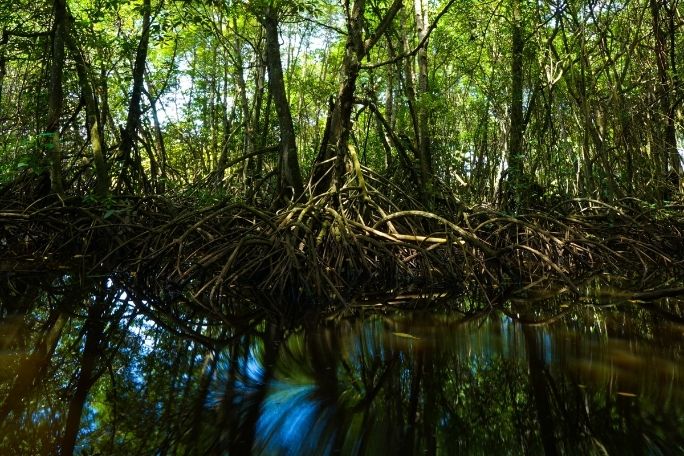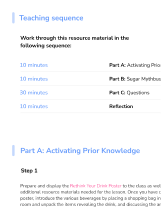Lesson summary
In this flipped classroom lesson, students are introduced to mangrove and salt marsh ecosystems, and explore values and attitudes toward conservation research by focusing on these tidal ecosystems in the context of the Great Barrier Reef World Heritage Area (or another local nearshore environment). Students explore human relationships with these ecosystems, and the flow of energy within and through these ecosystems through the use of food chains and webs. Students will also have the chance to learn about citizen science and the opportunities available through programs such as MangroveWatch, Earthwatch and ClimateWatch.
Learning intentions:
Students will...
- know some of the features of salt marsh and mangrove ecosystems
- understand the purpose and work of Earthwatch and MangroveWatch
- understand human impacts on mangrove and salt marsh ecosystems
- understand mangrove and salt marsh food webs and food chains.
Success criteria:
Students can...
- use an ecosystem model to explain the interaction of organisms and abiotic factors through processes of matter cycling and energy flow
- describe change within mangroves and salt marshes using examples of how this may influence the process of natural selection and diversity of living things
- analyse values of scientists, other students, teachers and community to clarify their own values toward MangroveWatch, a citizen science project
- access secondary sourced information about mangrove and salt marsh processes and components as preparation for questioning and predicting
- work independently to complete tasks in their own time.
Lesson guides and printables
Curriculum links
Select your curriculum from the options below.
Lesson details
Curriculum mapping
Australian curriculum content descriptions:
Year 9 Science:
- Ecosystems consist of communities of interdependent organisms and abiotic components of the environment; matter and energy flow through these systems (ACSSU176)
Year 10 Science:
- The theory of evolution by natural selection explains the diversity of living things and is supported by a range of scientific evidence (ACSSU185)
Year 9 Geography:
- Distribution and characteristics of biomes as regions with distinctive climates, soils, vegetation and productivity (ACHGK060)
Year 10 Geography:
- Human-induced environmental changes that challenge sustainability (ACHGK070)
- The Aboriginal and Torres Strait Islander Peoples’ approaches to custodial responsibility and environmental management in different regions of Australia (ACHGK072)
Year 11 and 12 Science – Biology
- Scientific knowledge can enable scientists to offer valid explanations and make reliable predictions (ACSBL013)
- Scientific knowledge can be used to develop and evaluate projected economic, social and environmental impacts and to design action for sustainability (ACSBL014)
- Biodiversity includes the diversity of species and ecosystems; measures of biodiversity rely on classification and are used to make comparisons across spatial and temporal scales (ACSBL015)
- Ecosystems are diverse, composed of varied habitats and can be described in terms of their component species, species interactions and the abiotic factors that make up the environment (ACSBL019)
- Models of ecosystem interactions (for example, food webs, successional models) can be used to predict the impact of change and are based on interpretation of and extrapolation from sample data (for example, data derived from ecosystem surveying techniques); the reliability of the model is determined by the representativeness of the sampling (ACSBL029)
Syllabus outcomes: SC5-14LW, GE5-1, GE5-2, GE5-3, GE5-4, GE5-5.
General capabilities: Critical and Creative Thinking, Literacy, Intercultural Understanding
Cross-curriculum priority:
Relevant parts of Year 9 Science achievement standards: Students analyse how biological systems function and respond to external changes with reference to interdependencies, energy transfers and flows of matter.
Relevant parts of Year 10 Science achievement standards: Students describe and analyse interactions and cycles within and between Earth’s spheres.
Relevant parts of Year 9 Geography achievement standards: Students analyse interconnections between people, places and environments and explain how these interconnections influence people, and change places and environments.
Relevant parts of Year 10 Geography achievement standards: Students identify, analyse and explain significant interconnections between people, places and environments and explain changes that result from these interconnections and their consequences.
Year 11 and 12 Science students:
- understand that ecosystem diversity and dynamics can be described and compared with reference to biotic and abiotic components and their interactions.
- understand how theories and models have developed based on evidence from multiple disciplines; and the uses and limitations of biological knowledge in a range of contexts.
- evaluate, with reference to empirical evidence, claims about relationships between and within species, diversity of and within ecosystems, and energy and matter flows.
Unit of work: MangroveWatch – Years 9 to 12
Time required: 120 minutes
Level of teacher scaffolding: Low – This lesson should be completed in students’ own time
Resources required
- Device capable of creating maps and satellite images using Google Maps
- Devices capable of presenting YouTube, interactive Google Maps, enlarged ecosystem flow charts, food webs and photographs to the class
- Student Worksheets – one copy per student
- About Mangrove and Salt Marsh Ecosystems
Skills
This lesson is designed to build students’ competencies in the following skills:
- Communication
- Community engagement
- Creativity
- Critical thinking
- Cultural understanding
- Empathy
Additional info
The lessons in this unit have been developed in partnership with Earthwatch and MangroveWatch. Earthwatch is a global not-for-profit organisation that uses citizen science to empower people to save the natural world, and works with all sectors to create a society that lives in balance with nature. MangroveWatch is a not-for-profit organisation that focuses on the research, education and conservation of mangrove and tidal wetland environments globally.


Welcome back!
Don't have an account yet?
Log in with:
Create your free Cool.org account.
Many of our resources are free, with an option to upgrade to Cool+ for premium content.
Already have an account?
Sign up with:
By signing up you accept Cool.org's Terms and Conditions(Opens in new tab) and Privacy Policy(Opens in new tab).